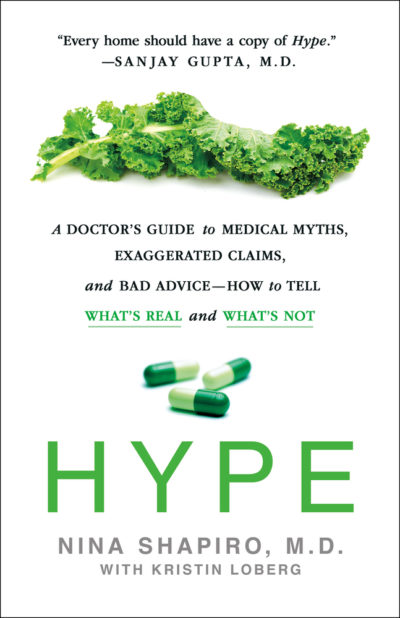We love our vitamins. Half of all American adults take a multivitamin or another vitamin or mineral supplement regularly. And 70 percent of people who are 65 or older take them. That amounts to more than $12 billion per year. According to Johns Hopkins, that money might be better spent on real sources of vitamins such as fruits, vegetables, healthy carbohydrates, and dairy products. In a 2013 editorial in the journal Annals of Internal Medicine titled “Enough Is Enough: Stop Wasting Money on Vitamin and Mineral Supplements,” Johns Hopkins researchers reviewed the data, homing in on three particularly alarming studies. One was an analysis of research involving 450,000 people, finding that multivitamins did not lower risk for cancer or heart disease. Another tracked multivitamin use of 5,947 men and their mental functioning over 12 years and found that multivitamins did not reduce risk for mental declines such as slowed thinking or memory loss. The third was a study of 1,708 heart attack survivors who were randomly split into two groups. For up to five years, one group took a high-dose multivitamin and minerals and the other took a placebo (the patients, the physicians caring for them, and study personnel did not know who was receiving a placebo or multivitamin-and-mineral pills). Rates of heart attacks, heart surgeries, and deaths later on were similar in the two groups.

What’s more, two other prominent studies spanning more than a decade, completed in 1995 and following tens of thousands of people, showed that beta-carotene and vitamin E supplementation in particular can be downright harmful, significantly increasing the risk of cancer. One of these entailed the landmark Framingham Heart Study, which had to end early because the investigators found that taking too much beta-carotene, at first thought to be a cancer-preventing supplement, was associated with significant increase in cancer-related deaths. All of these studies have been routinely reported in the media, but they don’t seem to change people’s nutritional-supplement habits. They don’t even sway me. I take a daily multivitamin. And vitamin C. When I have a cold, I go wild and take two Cs. And I even take vitamin D and calcium when I’m in the mood. My husband, also a doctor and a researcher, takes his share, and until our dentist implored me to stop, my kids had their gummy multis every morning.
The chief reason I take vitamins is for their placebo effect. This is the idea that if one thinks something helps, it does. I feel “healthier” taking vitamins. I feel that if my kids go heavy on the fries one day and skip their green beans, they may have gotten some much-needed nutrients in their vitamin.
I will not, however, megadose on anything (double- or even triple-dosing vitamin C, even up to 1,000 mg, is useless, but if used rarely is quite safe), and I would never rely on vitamin supplements to support genuine nutritional health or well-being. Vitamin boosts in drinks are powdery wastes of time and money. Are they dangerous? Probably not. Is there any evidence anywhere that they improve health? No. I work with nurses and doctors who are highly educated in science and medicine and are also quite health conscious. They exercise regularly and often follow their workouts with high-dose protein shakes and mega-vitamin-boosted juices. Will their muscles get bigger because of these drinks? No. But will these boosted drinks harm them? No. Their muscles get bigger because they lift weights, swim, or run. But again, I fall victim. As a busy surgeon, a protein bar of my brand of the month is often my lunch.
I routinely take completely unscientifically validated, yet entertaining, polls of medical staff — surgeons, nurses, residents, and medical assistants — regarding their vitamin intake. The simple question “Do you take vitamins?” leads to some pretty interesting answers, and no two are the same:
“I don’t… but I should.”
“No. Should I?”
“No, but my mom, who’s a pharmacist, ships me calcium from Amazon Prime.”
“I stopped taking multivitamins because I ran out of them.”
“I take E, C, D, B12, a multi, glucosamine, calcium, and fish oil.”
“Not really. Why? Okay — no, I don’t.”
“Every day.”
“No, but my kids do.”
Because of the minimal regulation of the contents of supplements, be they traditional vitamins or homeopathic herbs, one can never be sure of the actual contents. In 2012, the Department of Health and Human Services recommended that the FDA have more regulatory input on contents of supplements. Despite this, the FDA has no control. ConsumerLabs.com analyzed the actual vitamin content of several major vitamin supplements and found drastic differences in the amount of each vitamin compared to what the labels claimed. So aside from the quandary over whether to take vitamins, minerals, or homeopathic herbal supplements, we must question, Are we even getting what we think we are?
Investigators found that taking too much beta-carotene, at first thought to be cancer-preventing supplement, was associated with significant increase in cancer-related deaths.
Vitamins are essential for life and, by definition, are organic compounds required by a living organism. Currently there are 13 of them. The two main subsets of vitamins are fat soluble (can be dissolved in fat) and water soluble (can be dissolved in water). The fat-soluble vitamins — A, D, E, and K — can be stored in the liver and fatty tissues until they are needed, which is why we can get by without consuming them regularly. The water-soluble vitamins, B (which has several forms) and C, cannot be stored, which is why we need to consume them more regularly, and why “megadosing” or overdosing on them carries less danger.
Early primates lived in tropical regions containing vitamin-filled fruits and vegetables. Access to these in the diet of our ancestors likely led to the loss of certain gene activity that had been responsible for vitamin production in earlier life-forms. While vitamins are made by living cells, humans can synthesize only two of the necessary 13 — vitamin D is made in our skin, as sunlight enables the breakdown of a form of cholesterol, and vitamin K is produced in our livers. Other than those two, we need to take in vitamins from other sources, including bacteria, fungi, and plants. One hundred million years ago, our primate ancestors made their own vitamin C, but then because of mutations in our human code, we lost the ability to carry out all the steps in synthesizing vitamin C. Now we rely on plants for this vitamin, as did the hunter-gatherers tens of thousands of years ago.
Some may say that the term limey is pejorative when referring to Englishmen. But they earned this title for good reason. Despite its connotations in modern times, the term is a compliment. In the 17th and 18th centuries, as well as in many prior, likely including when Columbus was headed west, explorers and sailors at sea for weeks or months on end would often become deathly ill from an unknown cause — they would develop full-body aches, purple spots on their skin, swollen gums, rotting teeth, and sudden death. Unbeknownst to them, they were suffering from scurvy, a severe form of vitamin C deficiency. British sailors in the late 1800s realized that the lack of fruits and vegetables on these long voyages led to this disease and would travel with limes and lemon juice to avoid the illness. It worked (though at the time no one knew why). Thus the nickname limey. Not until the 20th century did the ingredient that prevented, and also cured, scurvy become known: vitamin C. In 1928, Albert Szent-Györgyi, a Hungarian biochemist, was one of several scientists to discover that the body requires certain organic substances, known as vital amines, in small amounts, the absence or deficiency of which would lead to various diseases such as scurvy.
Also in the 1800s, manufacturers began to process rice in mills, which stripped the outer layer of the rice grain. Soon after this, and as the consumption of rice became more widespread, people began losing feeling in their legs and were soon unable to walk. A few decades later, chickens developed a similar disorder. Those chickens had been fed primarily white rice. Once chickens were fed unprocessed (cheaper) rice, they remained healthy. In 1880, the Dutch physician Christiaan Eijkman found that both humans and avians eating processed rice were suffering from the ailment beriberi due to thiamine, or vitamin B1, deficiency. The outer layer of the rice grain is high in vitamin B1, and stripping this away led to vitamin deficiency.
Vitamin deficiencies are usually reviewed in biology classes, and even in medical school, in a historical context. In my daughter’s middle school science class, the students learned about rickets, a bone disorder caused by vitamin D deficiency. She learned that, in the 18th century, this deficiency was not due to lack of vitamin D pills but due to lack of sunlight for children working in a factory all day, then spending minimal time outdoors in fume-filled, sun-obscuring air. Many of these deficiencies still exist in developing nations, as well as in pockets of poverty in the United States. But for the most part, our overfed society is anything but vitamin deficient. So why are we under the impression that vitamin supplements, or “boosts,” make us healthier? The overwhelming majority of people get substantially more vitamins than are needed for sustenance and growth from a standard (even unbalanced) diet. So why are over half of us hooked on our daily pills?
In 1931, when American-bred Linus Pauling was just 30 years old, he published a paper in The Journal of the American Chemical Society providing an esoteric explanation of how chemical bonds are more complex than previously thought. This led to his winning the Nobel Prize in chemistry in 1954. Subsequent to this landmark study, he published several historically significant articles about protein structure, evolutionary biology, and molecular biology. He was also a world-renowned pacifist who opposed Japanese internment camps in the United States during World War II. He derided Robert Oppenheimer’s work on the Manhattan Project and declined an offer to work for it, and he vocally opposed nuclear arms. This led to his second Nobel — the Peace Prize — in 1962. He racked up multiple honorary degrees and awards over his lifetime, including the National Medal of Science and being one of 15 scientists named as Time magazine’s “Men of the Year” in 1961. He was a hero on so many fronts — a scientist, a humanitarian, a peace activist. But then things got strange.
The placebo effect is not fake. It is a real physiologic reaction.
In 1965, he attended a talk from a so-called doctor, Irwin Stone, a recipient of an honorary Ph.D. from the Los Angeles College of Chiropractics. Dr. Stone offered that the secret to longevity and feeling great while living a long life was vitamin C. He suggested that Pauling, then living the good life in Southern California, take a whopping 3,000 mg per day of vitamin C to feel better and live longer. Maybe it was the California sunshine that is so known to fry one’s brain that fried Linus Pauling’s into believing this. He soon claimed that taking 50 times the recommended daily dose of vitamin C (yes, that’s right, adults only need 60 mg per day, even though today’s vitamin C supplements range from 250 mg to 1,000 mg) made him feel more vibrant. And the “vitamin C fights a cold” myth came from this one quote: “… the severe colds I had suffered several times a year all my life no longer occurred. … I increased my intake of vitamin C to 10 times, then 20 times, and then 300 times the RDA: now 18,000 milligrams per day.” The first bona fide megadoser. And vitamin C — not protein chemistry, the advent of molecular biology, evolutionary biology, or peace activism — is what Linus Pauling will evermore be remembered for.
Maybe it was his advanced age (although 65 is hardly advanced in this day and age). Maybe it was the warm California sun. Maybe it was the positive vibes of his alternative lifestyle, the likes of which always seem to start on the West Coast. Maybe because he had been such a superstar in science at such a young age, he began to believe his own press releases. For whatever reason, Dr. Pauling had clearly gone off the deep end with vitamin C. Soon after he started making his claims in the early 1970s, he wrote an international bestseller at age 70 called Vitamin C and the Common Cold, later reprinted as Vitamin C, the Common Cold, and the Flu. In both books he recommends at least 3,000 mg per day of vitamin C to ward off these pesky common ills. What followed was the beginning of the vitamin C craze, with over 50 million Americans, me and my family included, taking vitamin C supplements to avoid and treat colds. I remember the slightly chalky, tart orange chewables I took daily as a kid. And I’d take two when I had a cold. Sometimes I didn’t feel like taking them, so I snuck them to my dog.
But here’s the irony: Countless large studies, looking at thousands of subjects, in a multitude of medical centers in the United States, Canada, and abroad, found no benefits from vitamin C supplements — no reduction in the incidence, severity, or duration of colds or the flu. But to this day, vitamin C remains not only one of the most common supplements sold, it’s now also sold as boosts in smoothies, or in packets to repel the evil humors while traveling. There is no evidence that these superboosts make any difference in frequency, severity, or duration of colds.
Most vitamins, taken without megadosing, are harmless, but the placebo effect that goes along with taking them is more powerful than most can imagine. The placebo effect is not fake — it is a real physiologic reaction that the body has when something people feel they do will make that change. This has been examined in countless drug studies, and, before stricter guidelines on human subjects were created, in sham surgery studies. I’m not suggesting that you should go out and take supplements because you can trick yourself into making them help you, even if you know they won’t. But I am saying that, for the most part, supplements taken in moderation (for instance, one multivitamin per day instead of seven) are less likely to harm you than help you. This is because people take supplements as part of a healthy lifestyle, and all that goes along with this, including eating well, exercising, and getting sleep. They’re simply part of the package. The science may show that vitamin X does not prevent disease Y, but if you feel that your vitamins help, then go for it.
However, I firmly believe that even though a prescription is not needed, these should each be discussed with one’s doctor. If a patient has had kidney or liver problems, a doctor needs to advise which vitamins should be avoided. If a patient is on certain prescribed or over-the-counter medications, the doctor needs to know so as to advise which herbal supplements should be avoided. If a patient is to undergo surgery, the surgeon needs the whole list, including supplements and herbs. Many patients don’t consider vitamins or herbal supplements medications, so they often leave this critical piece out of the puzzle.
I can’t tell you how many times I’ve asked, “What medications do you take?”
And the answer is “None.”
“No vitamins or supplements?”
“Oh, of course I take a multi, two Ds, ginkgo, fish oil, and a powder I received from my holistic specialist. But I don’t take any medications.”
Sigh.
Dr. Nina Shapiro is the award-winning Director of Pediatric Otolaryngology and a Professor of Head and Neck Surgery at UCLA, who has been featured in The New York Times, NPR, and CNN.com. Kristin Loberg is the No. 1 New York Times bestselling co-author of Grain Brain, A Short Look at a Long Life, and others.
This article is from the November/December 2018 issue of The Saturday Evening Post. Subscribe to the magazine for more art, inspiring stories, fiction, humor, and features from our archives.
Become a Saturday Evening Post member and enjoy unlimited access. Subscribe now





Comments
I say when I feel like catching a cold, I take a warm glass of water and 1 packet of EmergenC or a tab of Airborne twice a day . Voila yhe cold symptoms are gone. It either prevents or shorten the duration. Thanks for this article.